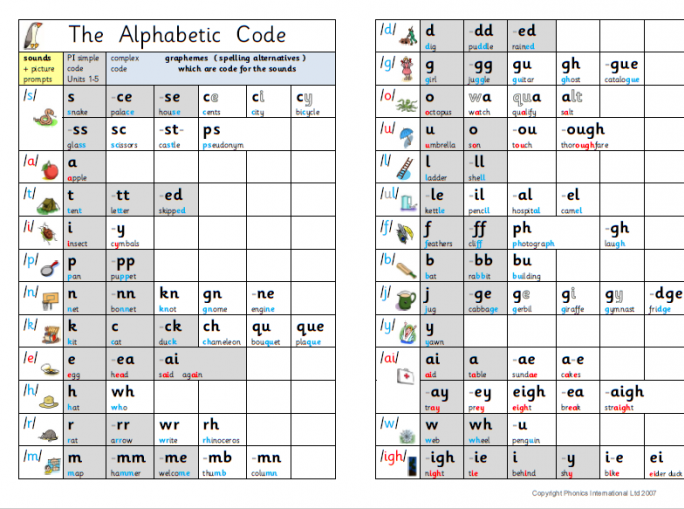10 Tips for Teaching the Complex Code

You may have heard that English is way too complicated and illogical to teach explicitly. This myth is one of the reasons that memorising words persists as a spelling strategy, but it is simply not true. What is true is that English has an opaque orthography. This means that the relationship between phonemes (sounds) and graphemes (letters that represent those phonemes) is, well….busy. The ‘basic code’ is reasonably simple. One alphabet letter represents consonants and the short vowels, with a few of the most consonant digraphs (sh, th, ch, ng), but from there it gets a bit more complex. In the ‘complex code’, one phoneme can be represented by more than one grapheme and one grapheme can represent more than one phoneme.
It might seem like the murky waters of our language would make it impossible to systematically and explicitly teach phoneme grapheme correspondences. The great news is that you can absolutely teach the complexity of the code to your students!
Here are 10 points to consider when thinking about a framework for arranging and teaching the complex code.
1. There seems to be two main ways that the complex code is taught:
A - Once the basic code is mastered, students are taught one representation of the remaining phonemes of Standard Australian English (SAE). Something like (ay, ee, igh, ow, oo, ar, or, air, er, ou, oy). I call this the ‘early complex code’ (that's just my explanation - it's not an official term). This means that students can represent just about all of the English code in their writing, even if their spelling isn’t correct. After that, the multiple representations of the whole code are taught.
B - Once the basic code is mastered, long vowels (ay, ee, igh, ow, u_e) and their multiple representations are introduced at once. Then multiple representations of the other phonemes of English.
There isn’t one, established and best way to do this. My only comment is that students who struggle to embed new connections into long term memory may well become confused by teaching representations of the same phoneme at once. The general guideline is that we space out the teaching of graphemes that are similar in appearance and phonemes that are similar in sound to aid memory retention and mastery. Even if your school uses a program that teaches multiple representations at once, you can still break them up if you want to.
Some people will state that the organising of the alphabetic code into simple and complex is a nonsense and that we should just teach it all as necessary. However, to me, this is a fast road to cognitive overload and confusion for many of our students. It is generally accepted that we begin to teach (what is really an abstract set of connections) in a simple way and then build up from there.

2. Some children can learn more than one new grapheme or representation at once and others really do need this teaching to be done one at a time
The way that your school approaches this very real difference in children’s memory and processing will be heavily dependent on your context, pedagogical foundations and the program in place if you use one. You might differentiate in how many representations you teach in the one lesson if you have a relatively small range of processing capacities in your classroom, but there’s nothing wrong with teaching just one grapheme or representation at a time. Note, I am not saying one per week. Whether you are teaching the basic or complex code, a rough guide is three representations per week on average. Your students won’t be disadvantaged by this more measured approach. I have recently written a post outlining a suggestion for the pacing of the complex code. You can access it here.

3. You aren’t going to do a full phonics lesson on the less common representations, such as ‘ai’ as /e/ in said. As these representations appear in such a limited number of words, you will simply address these as they are encountered, pointing out how the word is mapped and then providing practice of the spelling in your daily review.
4. Don't overthink review for graphemes that represent more than one phoneme
When you are flashing up graphemes one a time for students to develop automaticity, you will encounter graphemes with more than one phoneme (think oo and ea). In this case, just have the students say both phonemes you have taught so far. There is no way for them to know which one you are talking about without the context of words and sentences.
5. Retrieval practice can be a powerful tool
Once you have taught more than one representation of a phoneme, include regular retrieval practice where you ask the students to write down all the ways they know of how to represent a particular phoneme. This will be a great help when it comes to spelling where they might have to think of a number of options for a phoneme.

Image courtesy of Cult of Pedagogy
6. Alphabetic code charts are great for both you and the students
Having access to a good alphabetic code chart can be a great tool for yourself as a teacher to refer to for your own knowledge building, and as a tool in the classroom to refer to during lessons. Having a chart or a sound wall up is only effective if you actually include it in lessons and students understand what it is for. You can get access to the Phonics International free alphabetic code charts here.

7. Teach the spelling patterns and guidelines alongside the phoneme grapheme correspondence
For example, the ‘ai’ spelling as in rain would never be at the end of a word because English words don’t end in the letter ‘i’. However, the ‘ay’ spelling appears at the end of a word or syllable. There are 6 ways to spell this phoneme, so making sure you are aware of the patterns and guidelines is important. Where do you find this knowledge? Books such as ‘Uncovering the Logic of English’ by Denise Eid and ‘Spelling for Life’ by Lyn Stone and are your best friend here.
8. Word and sentence level practice still has a place in year 1 and 2
When teaching the complex code, continue to provide word level reading practice and decodable texts (books are great but decodable sentences are a good start if you don’t have more advanced decodable texts). It is important to avoid situations where students are asked to read with code they don’t know yet as it encourages guessing from pictures or the context of sentences.
9. Teach the Complex Code Explicitly
As with the basic code, the complex code is best taught explicitly. It might be tempting to use an analytical approach where you present a list of words and ask students to work out which phonemes the repeated grapheme represents, but this is a far less efficient method of instruction than simply telling students what the connections are and providing opportunities to read words and sentences with them. Of course, include both reading and writing and grapheme, word and sentence level. A good, solid instructional routine that you repeat can be very valuable.
10. Embed morphology in your phonics instruction
Remember to include prefixes and suffixes to the word and sentence work while teaching the complex code. In the early years, morphology isn’t the major focus, but it does need to be included. This can take the form of having students read the word ‘rain’ and then presenting ‘rains’, ‘rained’, ‘raining’ and ‘rainy’. Include these word families in transcription as well for a full experience. English is built on both phonemes and graphemes so morphology should be included in instruction.
The complex code might feel like a never-ending stream of content, but having a framework to build your and your students' knowledge on opens up a whole other level of engagement with reading and spelling. Teaching this knowledge just as explicitly and systematically as you would for the basic code means that every student in your class receives instruction that supports their needs.
If you missed my recent masterclass '3 ways to Make Reading Instruction your Superpower and would like to access a simple instructional routine for teaching the complex code, enter your details below and I will send one straight to your inbox.

 Jocelyn Seamer Education
Jocelyn Seamer Education
2 comments
Hi Jocelyn,
Love the points you raise here... Re: the alphabetic code charts (thanks Debbie Hepplewhite) I'm wondering if you could expand on how you might have used them to support students during writing instruction / practice. I've had them available for students to refer to but they can be a little overwhelming (even the simpler version), I really would like to offer some tools that go beyond my initial code sound wall, but wondering how to organise and introduce their use (or if other reference tools might also help).
Thanks again for another excellent blog...
Eldon Jenkin
Thank you for offering to send the instructional routine for teaching the complex code - it would be very helpful! All of your blog posts have helped me process my lesson plans for the beginning of our school year.
Leave a comment